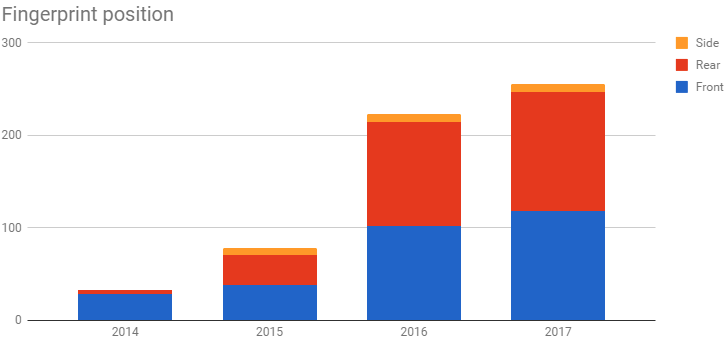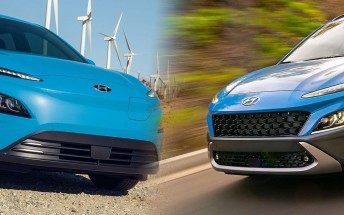Counterclockwise: the fingerprint reader goes back, front, back and side to side

The first phone with a fingerprint reader was the Pantech GI100 from 2004. It had a reader at the center of its D-Pad, one of those early implementations that required you to swipe your finger across them. This was a flip phone so the distinction between front and back is a bit iffy, but we’re calling this one front-mounted (based on when the phone is flipped open).
A few fingerprint readers appeared here and there over the years, but they were extremely rare – never exceeding 4 phones per year. It wasn’t until 2013 that biometric security became important in the public’s consciousness.
It was Apple’s doing, of course, the company is rarely the first but is always great at pushing new usage patterns. The iPhone 5s was one of two phones to have a fingerprint reader that year (front-mounted), the other was the HTC One Max (rear mounted).

Note: the chart counts the number of devices released, regardless of their popularity.
The very next year, 2014, there were 33 phones brandishing a reader and the overwhelming majority of them had it on the front (29 vs. 4). But by 2016 the balance had shifted to rear-mounted readers.
The Huawei Mate 10 showed that you can have both great screen-to-body ratio and a front-mounted reader, but we think the ergonomics don’t quite work out. If the bezel-less trend persists, most readers will migrate to the back.
Then there are the side-mounted readers. Pushed mostly by Sony but not exclusively – ZTE, Huawei and Nexbit (now owned by Razer) had side-mounted readers in 2015, the same year that Sony launched the Xperia Z5 and co. Still, these are a relative rarity.
There’s a good reason for that – just as the pursuit of slim bezels pushed the fingerprint reader away from the front, it’s pushing it off the sides too. A side-mounted reader increases the thickness of the side bezels and in turn the phone itself, damaging usability as excessive width is detrimental to handling.
Apple is trying to set a new trend now – no fingerprint reader at all! The iPhone X uses facial 3D scanning instead. That necessitated a notch at the top of the screen, though, and it’s not necessarily a good look (opinions certainly differ).
For completeness sake, here’s the fingerprint reader position chart from 2004 to 2014. We split it since the post-2013 boom skewed the combined chart and made it hard to read.

Related
Reader comments
- AnonD-632062
- 27 Nov 2017
- nCd
Someone at the HQ needs to learn how to make good, easily understandable charts....
- HP
- 27 Nov 2017
- tug
Based on your question, then fingerprint sensor is the fastest since we shall no need to look at the phone to unlock it. The fastest among all of those fingerprint scanner placement would be on the side mounted such like on the Sony Xperias and...
- Anonymous
- 27 Nov 2017
- tPG
Fingerprint sensor on the display will come in just a matter of time.








 Huawei
Huawei Samsung
Samsung Xiaomi
Xiaomi Huawei
Huawei Apple
Apple


